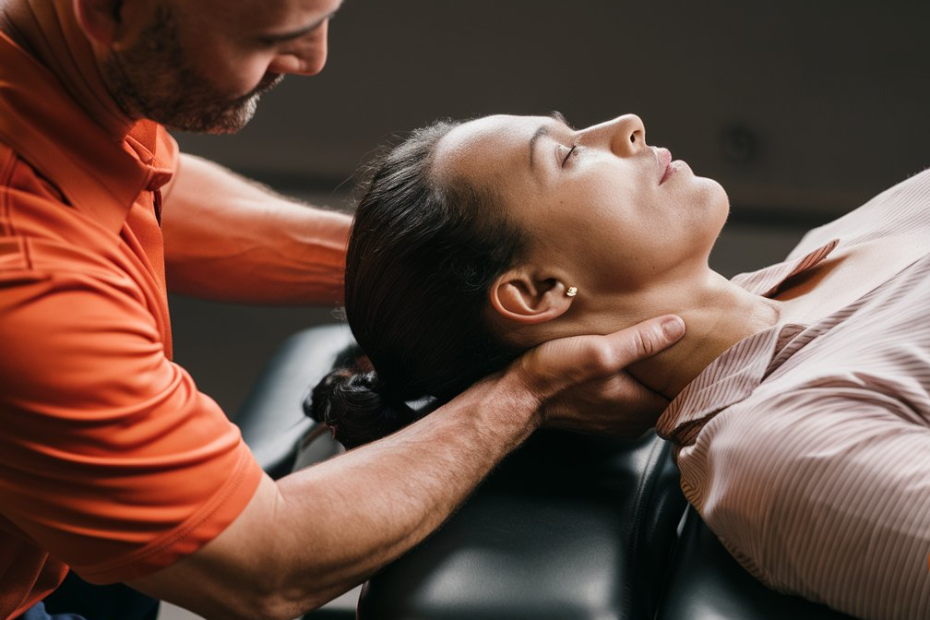If you’ve been dealing with chronic neck pain, you’ve probably wondered, “Should I see someone for hands-on treatment, or should I try an exercise program to strengthen my neck?”
It’s a common question I hear in Winnipeg, and the truth is that it’s not about choosing one or the other. A recent study in Musculoskeletal Science & Practice (2025) explored this very issue, and the results are encouraging.
What Did the Research Look At?
Researchers studied adults living with long-lasting chronic neck pain. Participants were split into two groups:
- One group received manual therapy, which included hands-on techniques such as gentle joint mobilizations, soft tissue therapy, and massage.
- The other group followed a structured exercise program designed to improve neck muscle strength and control.
Over time, both groups were tracked for changes in pain, movement, and daily function.
What Did the Study Find?
The results were clear: both treatments worked.
- Manual therapy often provided faster short-term relief, especially during painful flare-ups.
- Exercise was just as effective, but only when people stayed consistent with their program.
One of the most interesting findings was that people who completed about 95% of their exercises experienced results just as good as those who received manual therapy. That doesn’t mean you need to be perfect, but it does show that the closer you are to staying consistent, the better your neck is likely to feel.
The study also highlighted an added benefit of exercise: it improved control of the deep neck muscles, which support your head and spine. This helps prevent future flare-ups and maintain long-term function.

Manual Therapy vs Exercise: Which Is Better?
The simple answer is that both can be valuable, and often they work best when combined.
- Manual therapy is safe when performed by a licensed clinician. It can reduce stiffness, improve mobility, and calm down pain quickly. Many people find it helpful at the start of care when pain is high and movement feels restricted.
- Exercise programs build strength and control in the neck muscles. Over time, this helps reduce the risk of flare-ups and provides stability for everyday activities such as driving, working, or even sleeping comfortably.
In my experience, many patients try just one approach. Sometimes they do exercises on their own but don’t notice much change, or they get hands-on therapy for short-term relief but the pain keeps coming back. When we bring the two together, that is when people often see the biggest improvements.
My Approach in Winnipeg
When I meet someone with persistent neck pain, I always start with a full assessment. That helps me figure out whether you’ll benefit more from:
- Hands-on manual therapy to get you moving and reduce pain
- A personalized exercise program to build lasting strength and stability
- Or a combination of both
It’s never one-size-fits-all. Together, we decide on a plan that makes sense for your symptoms, your lifestyle, and your goals.
Common Symptoms of Chronic Neck Pain
If you’ve been struggling, you might recognize some of these:
- Neck stiffness or reduced range of motion, such as trouble turning your head or looking up and down
- Headaches linked to neck tension
- Muscle tightness or spasms in the neck and shoulders
- Pain radiating into the arms, sometimes with numbness or tingling
- Discomfort during daily tasks like driving, working at a computer, or doing chores
- Sleep disruption caused by pain or stiffness
These are all signs that your neck needs some extra support. The good news is that both manual therapy and exercise can help.
Is Manual Therapy Safe?
Yes. When performed by a trained, licensed professional, manual therapy is considered safe and effective for most people with chronic neck pain. The techniques are tailored to your comfort level and condition. If there are any concerns, such as nerve-related symptoms or other health issues, I always screen for them before beginning care.
The Bottom Line
The best approach isn’t about choosing one treatment over the other. Instead, it’s about finding the right balance between hands-on relief and exercise for long-term stability.
If you live in Winnipeg or the surrounding areas and your neck pain has been sticking around, I’d be happy to help you create a plan that works for you. Relief is possible now, and strength and control can last into the future.
Frequently Asked Questions
Q: Does manual therapy or exercise work faster for chronic neck pain?
Manual therapy often provides quicker relief in the short term, especially during flare-ups. Exercise builds longer-lasting stability when done consistently.
Q: How long does it take to feel better?
Some people notice relief within a few sessions of manual therapy. For exercise programs, improvements usually build over several weeks of regular practice.
Q: Do I have to choose between the two?
Not at all. In fact, combining them often gives the best results for those with chronic neck pain.
Q: Can neck pain come back even after treatment?
Yes. Flare-ups can happen, but exercise, especially deep neck muscle training, can reduce how often and how severe those flare-ups are.
Next Step: If you’re dealing with ongoing neck pain in Winnipeg, let’s put together a personalized plan that helps you feel better now and keeps you moving well in the future.
Originally posted on September 23, 2025 @ 11:59 am
